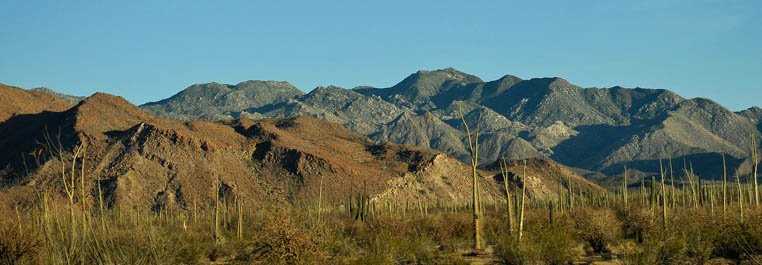The sea lay flat and calm and looked like a golden-colored mirror. Blue reflections of the sky radiated out in small swells from the many Heermann’s gulls that landed and picked up tiny swimming crabs. The stunning volcanic mountains of the Isla Angél de la Guarda’s ridgeline reflected in the water on the west side of the ship. Brick reds, coarse pinks, and pale greens and yellows were as beautiful in the reflections as they were in the cliffs themselves. A blow erupted to add another element to the scene. It was a small fin whale that fed nearby. It stayed through breakfast, continuing to feed. Those on Zodiac tours were later able find three more.
Our guests hiked into a small canyon that wound its way into the deeper parts of this rough, raw landscape. A gently rising arroyo was filled with smoke trees, palo verdes, and many large cardon cactuses. Black-tailed gnatcatchers visited some of us as ravens close to a nearby nest looked down on those photographing two large blue palms in the canyon bottom. Beachcombers found gorgonians, a paper nautilus, beautifully ridged scallops, and shells called turkey wings.
Cruising in the middle of the day continued to be upon glassy water, interrupted only by Craveri’s murrelets, Pacific loons, eared grebes, and an occasional light breeze that rippled the surface. We arrived at Bahía de los Angelés by mid-afternoon and were soon traveling up and into the mountains. Granite gave the distant hilltops a cleaner looking color than the darker volcanic surroundings. We soon passed into an area of white-barked elephant trees that gave way to tall, light-colored shafts sticking 40 to 50 feet straight up like skinny carrots. We had arrived in boojum country! These bizarre plants occur in Baja California and in the western parts of Sonora, and nowhere else in the world.
We stopped at a local ranch and introduced ourselves to boojums. Photographers used all of their talents of composition to capture a subject that seems to defy the rule of thirds. Many stayed until sunset for the magic light on plants and the surrounding hillsides. Birders found the area to be productive for Say’s phoebes and ash-throated flycatchers, an elusive gray thrasher, scrub jay, Costa’s hummingbirds and many others. Cacti were in bloom as well as the bright red flowers of bellaperone, palo adan, and ocotillo, but disappearing light finally encouraged our departure.
On our ride back we looked down on Bahía de los Angeles and the surrounding islands. The most prominent was the 1320-foot-high Isla Coronado, also known as Isla Smith. This dormant strato-volcano had fumarolic activity in 1539. That didn’t bother us much at the cantina as the beer slid down in the fading light.







